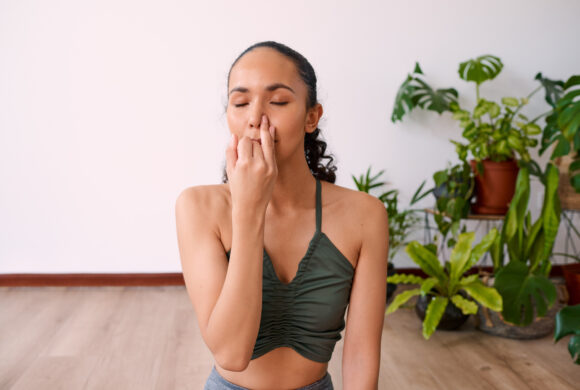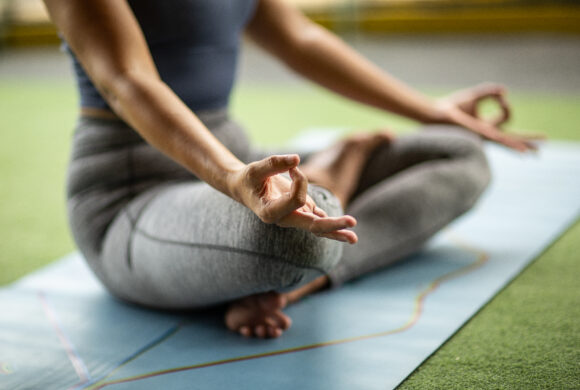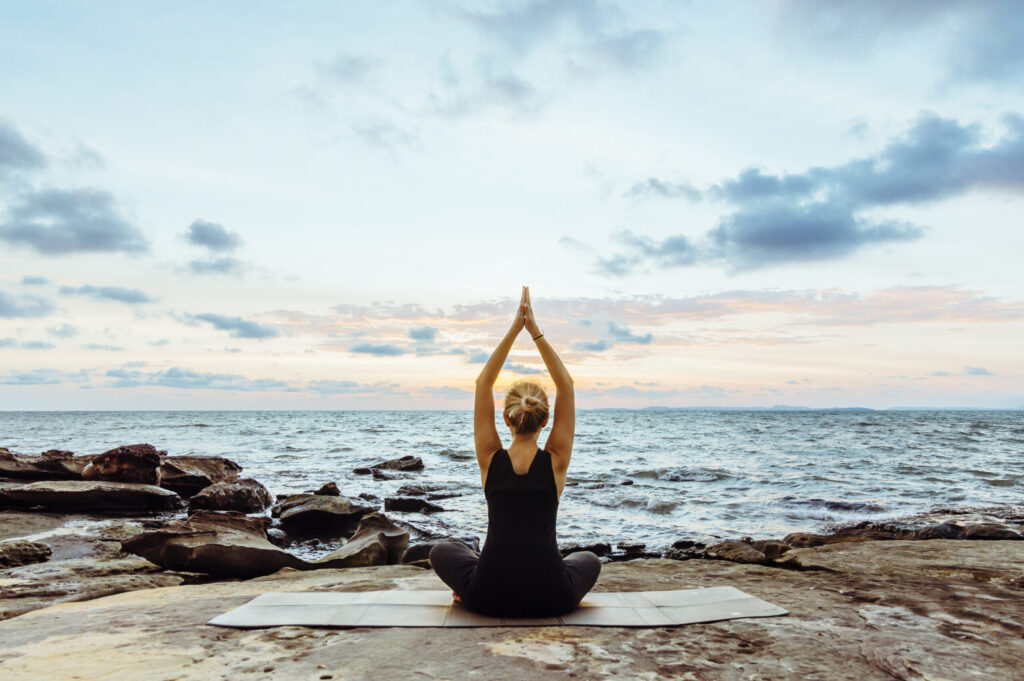Like peas in a pod, Ayurveda and Yoga are distinct disciplines but come from the same source. They are both rooted in Vedic wisdom, which is a 5,000-year-old body of knowledge from the present-day Indian subcontinent. Today, Yoga in the West is strongly focused on the physical aspect (asanas) of yoga practice and straddles the fitness industry. It offers incredible benefits for the body, although it’s also a tool for the mind and heart. And while Ayurveda is commonly known for supporting the health of the body through interventions like herbs, it also addresses the mind, consciousness, and psychology. Professionals may choose to specialize in Ayurveda or Yoga, as that is how most of the training and education is offered. And so, as consumers, we often find them as separate offerings even though they are inherently connected.
In the past, Yoga was a discipline reserved for particular initiates. Nowadays, the blessings of Yoga reach far and wide. Meditation, fitness, and healing instructors are more creative each day, with novel styles emerging like aerial Yoga, goat Yoga, nude Yoga and so many more. While “Ayurvedic Yoga” might not be as trendy, it is powerfully healing. In this article, we explore several ways in which you can incorporate Ayurveda into your personal or teaching Yoga practice.
Align your practice with nature
Ayurveda’s first goal is to “preserve the health of the healthy.” This goal is accomplished primarily through lifestyle practices that are in harmony with nature. This includes all the daily choices you make, from when to get up to what to eat for lunch, to when to exercise and go to bed. All these choices are vital for optimal health, though we’ll focus on the ones that relate most to your Yoga practice.
Be in tune with the circadian rhythms
Timing is everything. To make the most of your practice, breathe and stretch by the Ayurvedic clock.
What’s the Ayurvedic clock? It’s the concept of synching time periods with our various energy levels. It provides us with guidance on the optimal times to engage in activities such as eating, sleeping, practicing yoga, and more.
Here’s how you can apply the clock to your Ayurveda and Yoga practice:
- Early to bed and early to rise. Bedtime by 10-10:30 pm is optimal, as is rising around 6 am.
- Early morning is considered the optimal time for Yoga practice. Between 4-6 am, when the atmosphere is most subtle, it’s considered the “magical hour” for Yogis.
- Mid-afternoon power practices are very popular. Ensure you have a good breakfast on afternoon Yoga days, and practice prior to lunch.
- Alternate your practice with your meals. Wait at least 1 hour after a meal for your practice. Asana and Pranayama (breath work) especially should not be performed on a full stomach.
- If you opt for evening practice, go slower. A Restorative or Yin class is ideal at night to assist your mind and body with preparing for sleep.

Adopt a seasonal asana practice for maximum benefits
One of the most beautiful experiences is practicing with the season. As the months usher in new levels of heat, cold, dryness, and moisture, your asana practice can help you adapt to these changes.
Changing up your postures, breath work, mantras, and mudras with the seasons adds depth to your practice. According to Ayurveda “there’s no inside or outside,” which means that the changes in the weather impact you and your internal mind-body system. If you take cues from nature and adapt your poses and styles throughout the seasons, you may notice that your practice is easier and more intuitive.
You may also notice that you suffer less from seasonal imbalances and even appreciate your least favorite seasons a bit more. This is all possible using the Ayurvedic science of the elements and qualities. When a season increases certain elements, you can compensate by introducing counterbalancing elements in the practice. Personalizing an Ayurveda and yoga seasonal practice can be as simple as favoring key styles or poses that provide this counterbalancing impact. Teachers can advertise classes as “seasonal,” though it may be more appealing and beneficial to students to incorporate seasonality into classes by default.
Late Winter and Early-Mid Spring (Kapha Season)
The weather is wetter and cooler. Your body may tend to feel a little heavier and find your motivation to practice lacking. To balance Kapha you should opt for asana that is detoxifying, energizing, and warming.
- Surya Namaskar (sun salutations) generates heat when practiced with vigor. Incorporating chest opening hand movements will help stimulate the lungs and sinuses, the main sites of Kapha.
- Backbends also provide an opening to the chest and lungs. Natarajasana (king dancer), urdhva dhanurasana (upward-facing bow), and salabhasana (locust) are all fitting options.
- Inversions such as adho mukha savasana (downward facing dog) and ardha pincha mayurasana (dolphin) are great for beginner yogis and help stimulate circulation and bring a feeling of lightness to the body.
Late Spring, Summer, and Early Fall (Pitta Season)
The weather is warm or hot, after all, Pitta is all about fire, so asana should be cooling and calming.
- Time to slow your practice down a bit. Avoid the power yoga sessions and instead opt for more gentle flows and/or restorative practices.
- The main site of Pitta in the body is the navel and solar plexus areas so opt for poses that include side bends and twists or backbends such as bhujangasana (cobra), dhanurasana (bow), matsyasana (fish).
Mid Fall through Early Winter (Vata Season)
Cooler, dryer, and more mobile (windy) weather call for asana that is warming, stabilizing, and calming in nature.
- Standing poses such as virabhadrasana (warrior poses) bring stabilization and grounding. Balancing poses like vrksasana (tree pose) help focus the mind and create rooting or grounding with the earth.
- Malasana (garland pose), balasana (child’s pose), and pavanmuktasana (wind-relieving pose) also bring grounding qualities.
- Prone backbends like bhujangasana (cobra pose) and dhanurasana (bow pose) help bring heat to the spine and lower back while uttanasana (standing forward fold) provides warmth to the internal organs.

Practice breath work based on your constitution and imbalances
Breathwork (pranayama) to balance the Doshas
Pranayama calms and soothes the nervous system, bringing the mind closer to a meditative state. Beneficial for all Doshas, an Ayurveda and yoga Pranayama practice can benefit physical imbalances as well as disorders of the emotional body.
Pranayama for Kapha
Ujjayi or victorious breath and Kapalabhati are two excellent breath practices for Kapha. Both are heating in nature and beneficial for stroking the digestive fire, or Agni.
- Ujjayi involves a slight constriction of the throat muscles causing the air to create an audible vibration as it passes over the vocal cords. Working on the middle sinuses and throat, it creates a subtle state of mind.
- Kapalabhati or “shining skull” breath is practiced by alternating short, explosive exhales with slightly longer, passive inhales bringing cleansing to the nasal passages.
Pranayama for Pitta
Cooling forms of pranayama can reduce Pitta and enkindle subtler aspects of Agni, including the fire of the mind. Shitali and Sitkari are two cooling pranayama practices beneficial for Pitta types.
- To practice Shitali breath, the air is inhaled through the mouth, like sucking water through a straw, and exhaled through the nostrils.
- Sitkari breath, known to clear heat from the head and cool the emotions, starts with the tip of the tongue pressed to the palette as air is drawn in through closed teeth, the mouth is then opened as breath is released through the nose.
Pranayama for Vata
Breath control can be very soothing for Vata in both the mind and body.
- Kalabalapti breath practiced first thing in the morning increases Apana Vayu aiding in elimination and cleansing of the bowls.
- Surya bedhana brings warmth and Bhastrika breath, a rapid forceful breath controlled by the diaphragm, can be used for Vata-related issues impacting the nervous system and joints.

Ayurveda and Yoga meditation techniques to balance the mind
The objective of Meditation or Dhyana is to stabilize your mind. It helps you to develop the objectivity to see yourself and the world as they are. Meditation is a time to turn inward with contemplation and exploration of your deeper self. When done regularly, it removes the layers of conditioning that prevent you from seeing life as it is, bringing healing to your mind, body, and spirit. The ultimate goal: a connection of your individual consciousness with that of the universe.
Vata Dosha Meditation
Vata imbalance often brings anxiety, distraction, and lack of focus. The activeness of the mind continually brings subconscious thoughts to the surface causing the mind to wander and making meditation challenging. Chanting mantras, repetition of a word, phrase and/or sound, is an effective way to harness an active Vata mind. The repetition drowns out the many sounds and words within the thoughts shifting the mind from a rajasic to a sattvic state.
Pitta Dosha Meditation
The most common Pitta imbalances include anger, impatience, and perfectionism. Heart chakra or loving kindness-themed meditations offer the opportunity to develop compassion while third eye and crown chakra themes bring spiritual awareness to often-objectified practices. Cooling imagery and mudras also help pacify Pitta.
Kapha Dosha Meditation
Imbalance for Kapha often tends to involve heaviness and can manifest into a form of attachment to things or points in time. Given a tendency to hold onto the past, a meditation practice that allows focusing on present-moment awareness can be helpful. Kirtan singing can also be a great meditation technique as it clears emotional heaviness and strengthens the lungs which can often become congested during Kapha imbalance.
David Frawley, well known ayurvedic teacher, and Vedic philosopher states it best, “There is no need for any Yogic system of medicine apart from Ayurveda, and there is no Yoga Chikitsa (therapy) apart from Ayurveda”. When Ayurveda and yoga are practiced together, the result is an elevated practice that brings harmony and balance to your body, mind, and spirit.






